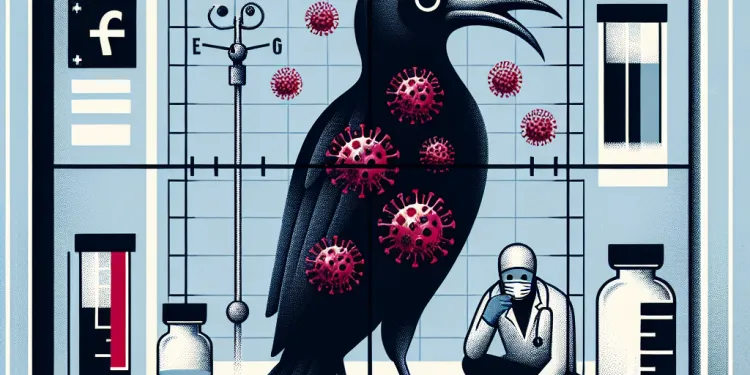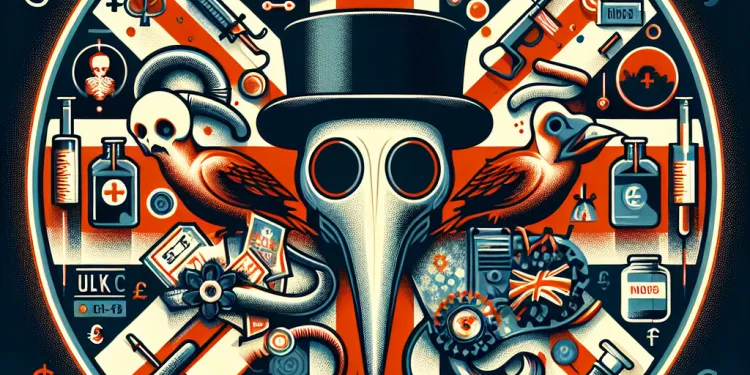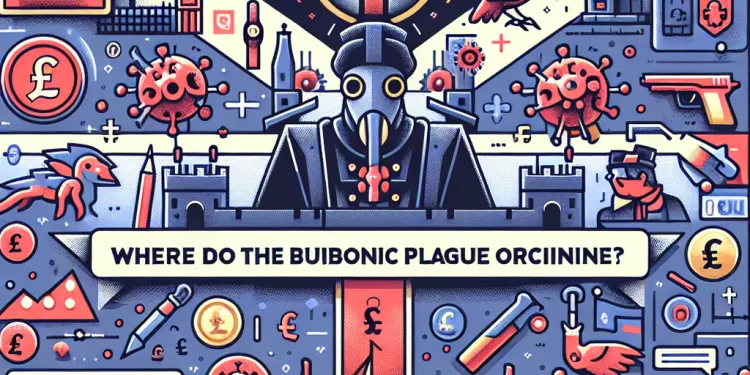
Find Help
More Items From Ergsy search
-

What is a bubo?
Relevance: 100%
-

What are the symptoms of the bubonic plague?
Relevance: 37%
-

What is Bubonic Plague?
Relevance: 31%
-

What is the bubonic plague?
Relevance: 26%
-

What historical event is the bubonic plague known for?
Relevance: 13%
-

Is the bubonic plague contagious between humans?
Relevance: 12%
-

What is the mortality rate of untreated bubonic plague?
Relevance: 12%
-

Where did the bubonic plague originate?
Relevance: 8%
-

Did the bubonic plague affect only Europe?
Relevance: 6%
-

How can the bubonic plague be treated?
Relevance: 6%
What is a Bubo?
A bubo is a swollen, inflamed lymph node, commonly associated with infections such as the bubonic plague, cat-scratch disease, and some sexually transmitted infections like lymphogranuloma venereum. The term "bubo" is derived from the Greek word "boubon," meaning groin, reflecting the appearance of such swellings in the groin area in many cases. Buboes can also occur in the armpit and neck regions, depending on the infection source and progression.
Causes of Buboes
Buboes are most famously linked to the bubonic plague, caused by the bacterium Yersinia pestis. The plague ravaged Europe during the Middle Ages, causing widespread mortality and historical significance. However, Yersinia pestis is not the only cause. Cat-scratch disease, caused by Bartonella henselae, and lymphogranuloma venereum, due to certain strains of the bacterium Chlamydia trachomatis, can also result in bubo formation.
Symptoms and Diagnosis
A bubo presents as a noticeable swelling of the lymph node, often tender and painful to the touch. The skin overlying a bubo might appear red and feel warm. Accompanying symptoms depend on the underlying infection but can include fever, chills, fatigue, and other systemic signs of infection. Diagnosis typically involves a combination of clinical examination, patient history, and laboratory tests. Physicians may aspirate the bubo to obtain fluid for microbiological culture or perform blood tests to identify the causative pathogen.
Treatment
Treatment of buboes depends on addressing the underlying infection. Antibiotics are the mainstay of treatment for bacterial infections such as those caused by Yersinia pestis or Bartonella henselae. For the bubonic plague, antibiotics like doxycycline or ciprofloxacin are typically prescribed. In some cases, the draining or surgical removal of buboes may be necessary, especially if they become persistently large or painful.
Prevention and Public Health
Preventing buboes involves controlling the spread of infectious diseases that cause them. For the bubonic plague, this includes reducing rodent populations and preventing flea bites, as fleas are a vector for Yersinia pestis. Maintaining good hygiene when handling domestic animals can reduce the risk of cat-scratch disease. In terms of sexually transmitted infections like lymphogranuloma venereum, practicing safe sex and routine screening can help prevent transmission.
Conclusion
While historically significant, buboes are a medical condition that can arise from various infections. Understanding their causes, treatments, and preventative measures can help in managing their incidence. Modern medicine has greatly reduced the threat posed by conditions like the bubonic plague, yet awareness and early intervention remain key in handling cases when they do arise.
What is a Bubo?
A bubo is a swollen bump that you can get on your body. It happens because of some germs that make you sick. These germs can cause diseases like the bubonic plague, cat-scratch disease, and some infections you get from sexual contact. A bubo can look like a lump in places like your groin, armpit, or neck. The word "bubo" comes from an old Greek word that means "groin".
Causes of Buboes
The bubonic plague is the most famous cause of buboes. It comes from a germ called Yersinia pestis. This disease made many people sick in Europe a long time ago. Other germs can also cause buboes, like the germs from cat scratches and sexual contact. These germs make the bumps appear.
Symptoms and Diagnosis
A bubo looks like a big bump. It can hurt if you touch it, and the skin on it might be red and warm. If you have a bubo, you might also have a fever, feel very tired, or have chills. To find out if you have a bubo, doctors will look at your body and ask questions about how you feel. They might test the fluid in the bubo or do blood tests to see what germ is making you sick.
Treatment
To treat a bubo, doctors focus on getting rid of the germ causing it. They give you medicine called antibiotics to kill the germs, especially for diseases like the bubonic plague and cat-scratch disease. Sometimes doctors might need to drain the bubo or remove it if it is very big or hurts a lot.
Prevention and Public Health
To stop buboes from happening, we need to stop the germs that cause them. For the plague, we should keep away from fleas and control rats, because fleas pass the germs from rats. Washing your hands when handling pets can help stop cat-scratch disease. To avoid infections from sexual contact, use protection and get regular health check-ups.
Conclusion
Buboes are bumps caused by some germs that make us sick. Knowing what causes them and how to treat them helps us stay healthy. Even though modern medicine helps us a lot, it is important to know about buboes and see a doctor early if you think you might have one.
Frequently Asked Questions
What is a bubo?
A bubo is a swollen, painful lymph node due to infection, often associated with bubonic plague and other diseases.
What causes a bubo?
Buboes are caused by bacterial infections such as Yersinia pestis, the bacterium responsible for the bubonic plague, or other infections like tularemia and cat-scratch disease.
What are the symptoms of a bubo?
Symptoms include a swollen, painful lymph node, redness, warmth, and sometimes fever or chills.
Where are buboes typically located on the body?
Buboes commonly appear in the groin, armpit, or neck regions.
How is a bubo diagnosed?
A bubo is diagnosed through physical examination and may require laboratory tests to determine the underlying infection.
Can a bubo be treated?
Yes, treatment typically involves antibiotics to treat the underlying infection, and pain relief for symptoms.
Is a bubo contagious?
The bubo itself is not contagious, but the underlying infection that causes it, like plague, might be contagious.
How long does it take for a bubo to heal?
The healing time for a bubo depends on the treatment and severity of the infection, usually improving within a couple of weeks with antibiotics.
What historical significance do buboes have?
Buboes are historically significant as a notable symptom of the bubonic plague, which caused significant mortality in past pandemics.
Do buboes only occur in humans?
No, other animals can also develop buboes if they are infected with bacteria like Yersinia pestis.
What is the difference between a bubo and an abscess?
A bubo is a swollen lymph node due to infection, whereas an abscess is a collection of pus that can occur anywhere in the body.
Can a bubo rupture or drain on its own?
Yes, a bubo can sometimes spontaneously rupture or drain, releasing pus; medical intervention may be needed to manage this.
What are the risk factors for developing a bubo?
Risk factors include exposure to infected animals, flea bites, or contact with someone with a transmissible infection like the plague.
Can buboes be prevented?
Preventing buboes involves reducing exposure to the bacteria causing the infection, which may include controlling flea populations and avoiding contact with infected animals.
What other diseases can cause buboes?
In addition to bubonic plague, diseases like cat-scratch fever and tularemia can also lead to the formation of buboes.
What tests are used to identify the cause of a bubo?
Tests may include blood tests, cultures, and imaging studies to find the underlying infection causing the bubo.
Does having a bubo always indicate bubonic plague?
No, while buboes are associated with bubonic plague, they can also occur with other infections.
What are common misconceptions about buboes?
A common misconception is that buboes exclusively indicate the plague, while they can result from other bacterial infections as well.
How should a bubo be properly cared for?
Proper care involves following prescribed antibiotic treatments, keeping the area clean, and possibly draining if directed by a healthcare professional.
What should you do if you suspect you have a bubo?
Seek medical attention to get an accurate diagnosis and receive appropriate treatment for any underlying infection.
What is a bubo?
A bubo is a lump or bump. It can appear on your body when you are sick. If you see or feel a bubo, it is good to tell a grown-up or a doctor. They can help you. You might use a picture book or app to help you understand what a bubo is.
A bubo is a big, sore lump on your body. It is from an infection. It can happen when you have certain illnesses like the bubonic plague.
What makes a bubo happen?
Buboes are lumps on the body caused by germs. These germs can come from illnesses like the bubonic plague, tularemia, or cat-scratch disease.
What signs show you have a bubo?
A bubo is a sore bump under your skin. Here is what you can look for:
- A big, sore lump on your neck, under your arm, or in your groin.
- The lump might hurt when you touch it.
- You might also feel sick, like having a fever.
If you think you have a bubo, you should tell a grown-up or see a doctor. They can help you feel better.
Tools to help:
- Ask someone to read this to you.
- Use a dictionary to understand new words.
- Talk to a doctor for advice.
If you are sick, you might have a lump that is sore and hurts. This is called a swollen lymph node. The area might look red and feel hot. You might also get a fever or feel very cold.
To feel better, you can:
- Ask an adult to help you see a doctor.
- Use a warm cloth on the sore spot.
- Rest and drink lots of water.
Where do buboes usually appear on the body?
Buboes are lumps that might show up when you are sick. They often appear in three places:
- Your neck
- Your armpits
- Your groin (the top part of your legs)
If you or a friend have a bubo, it is important to tell an adult or see a doctor. You can use a simple picture diagram to see where these places are on your body.
Buboes are bumps that often show up in the places where your legs meet your body, under your arms, or on your neck.
How do doctors find out if you have a bubo?
A doctor finds a bubo by looking at your body. Sometimes, they need to do special tests to find out what is causing the infection.
Can you help a bubo get better?
Yes, doctors usually use medicine called antibiotics to help fight the infection. They also give medicine to help with pain.
Can you catch a bubo from someone?
A bubo is a bump on the skin. The bump can’t spread to other people. But the sickness that causes the bubo, like the plague, can spread to others.
How long does it take for a bubo to get better?
A bubo is a swollen lump. It can take some time to heal.
Here are some tips to help you:
- Rest as much as you can.
- Keep the area clean.
- Drink lots of water.
- Ask a grown-up or doctor for advice.
If you find reading hard, you can:
- Listen to an audio version of the text.
- Use pictures or videos to understand better.
How fast a bubo gets better depends on how strong the infection is and the medicine used. With the right medicine, a bubo usually gets better in about two weeks.
Why are buboes important in history?
Buboes are important because they were a big sign of the bubonic plague, a disease that made many people very sick and caused many deaths a long time ago.
Do buboes only happen to people?
Buboes can also happen to some animals, like rats and mice.
If you find this hard to read, try using a tool that reads the text out loud.
No, not just humans. Other animals can get lumps called buboes too. This happens if they get sick from germs like Yersinia pestis.
What is the difference between a bubo and an abscess?
Bubo and abscess are two types of swelling in the body. They are different in how they form and what they mean.
Bubo: A bubo is a swollen lump. It shows up when your body is fighting an infection. The lump is made of lymph nodes. These are small glands that help fight germs. You can find buboes where you have lymph nodes, like your neck, armpits, or groin.
Abscess: An abscess is a pocket of pus. It happens when your body tries to fight germs and the area gets infected. Pus is a thick, yellowish fluid. Abscesses can happen anywhere on your body.
If you think you have a bubo or abscess, tell an adult or see a doctor. They can help you get the right treatment.
It can be helpful to use a dictionary to understand hard words. You can also ask someone to explain these words to you.
A bubo is a big lump under your skin caused by an infection. An abscess is a place in your body where pus collects, like a pocket full of pus. It can happen anywhere in your body.
Can a swollen bump burst by itself?
Yes, a bubo might pop or leak yellow or green stuff called pus. A doctor might need to help make it better.
What can make you get a bubo?
Things that can make you sick are:
- Being near sick animals
- Getting bitten by fleas
- Being around someone who is sick and can give it to you, like the plague
If you find it hard to remember, you can make a list or use pictures to help you understand.
Can you stop buboes from happening?
To stop buboes, try to stay away from germs that make you sick. You can do this by keeping fleas away and not touching animals that might be sick.
What other illnesses can make lumps under the skin?
Buboes are bumps that can happen on your body when you get sick. Bubonic plague can cause buboes, and so can other illnesses like cat-scratch fever and tularemia.
What tests help find out the cause of a bubo?
Doctors do different tests to find out why a bubo is there. A bubo is a lump. Here is how they check:
- Blood test: They take some blood to see if there are germs.
- Swab test: They use a cotton stick to take a little bit from the bubo.
- Imaging test: They use a machine to take pictures inside the body.
If it’s hard to understand, you can:
- Ask a doctor or nurse to explain.
- Use pictures to learn about the tests.
- Bring a friend or family member to help you.
Doctors might do blood tests, take samples, or use machines to look inside the body to find out what infection is making the bubo.
Does a bubo always mean you have bubonic plague?
A bubo is a lump that can happen when you are sick. Sometimes, people think a bubo means you have a disease called bubonic plague. But, having a bubo does not always mean you have this disease.
If you have a bubo, it's a good idea to see a doctor. They can help you find out why you have it.
Using simple reading tools like big letters or pictures can help if you find reading hard. You can also ask someone to read this to you.
No, buboes are not only from bubonic plague. They can happen with other infections too.
What do people often get wrong about buboes?
Many people think that buboes only show up when someone has the plague. But buboes can also happen because of other types of infections caused by bacteria.
How do you take care of a bubo?
Taking care of yourself is important. You should take medicine if the doctor gave you some, keep the area clean, and let the doctor know if they said you might need extra help like draining fluid.
What to do if you think you have a bubo
If you have a bump or swelling under your skin, it might be a bubo.
Here are some steps you can take:
- Tell an adult you trust, like a parent or teacher.
- Ask to see a doctor. They can help you feel better.
- Write down when you first saw the bump and how it feels.
- Look at some pictures in a book or online to learn more.
- Keep clean and wash your hands often.
For help with reading, try using pictures or ask someone to read with you.
See a doctor to find out what is wrong and get the right medicine if you have an infection.
Useful Links
- Ergsy carfully checks the information in the videos we provide here.
- Videos shown by Youtube after a video has completed, have NOT been reviewed by ERGSY.
- To view, click the arrow in centre of video.
- Most of the videos you find here will have subtitles and/or closed captions available.
- You may need to turn these on, and choose your preferred language.
- Go to the video you'd like to watch.
- If closed captions (CC) are available, settings will be visible on the bottom right of the video player.
- To turn on Captions, click settings .
- To turn off Captions, click settings again.
More Items From Ergsy search
-

What is a bubo?
Relevance: 100%
-

What are the symptoms of the bubonic plague?
Relevance: 37%
-

What is Bubonic Plague?
Relevance: 31%
-

What is the bubonic plague?
Relevance: 26%
-

What historical event is the bubonic plague known for?
Relevance: 13%
-

Is the bubonic plague contagious between humans?
Relevance: 12%
-

What is the mortality rate of untreated bubonic plague?
Relevance: 12%
-

Where did the bubonic plague originate?
Relevance: 8%
-

Did the bubonic plague affect only Europe?
Relevance: 6%
-

How can the bubonic plague be treated?
Relevance: 6%




